Best bird feeder: Don’t let your feathered friends go hungry
The best bird feeder should be attractive to visitors, protective and easy-to-clean

Investing in the best bird feeder for your yard has multiple benefits for both you and any feathered friends who decide to check out what you have to offer. The most obvious is that you’re providing a source of food, which helps to maintain bird populations especially when natural crops are in short supply. It also gives you an opportunity to see birds up-close and watch them as they come and go.
As you’ll see from this guide, there are many different types of feeders and they’re generally created to suit different types of wild birds. Tube-style and hopper-style feeders, for example, are aimed at smaller birds while ground or platform feeders are better for larger birds.
“Your decision-making may be based on which type of species you want to encourage into your garden or perhaps the population you already have and want to support,” says expert vet Dr Rebecca MacMillan.
It may even be the case that you will want more than one feeder. “Keen bird fanatics may want a selection of feeders with several types of the best bird food to attract a variety of species into their garden,” Dr MacMillan adds.
Just be sure to learn how to attract birds to your garden and check out the best squirrel-proof bird feeders if it’s likely pesky rodents will seek to nibble on any food you leave. With greater peace-of-mind, you can sit back and watch as cardinals, blue jays, hummingbirds, Goldfinches and more head your way. So let’s take a look at the best bird feeders on the market today.
Best bird feeders 2025
Why you can trust PetsRadar
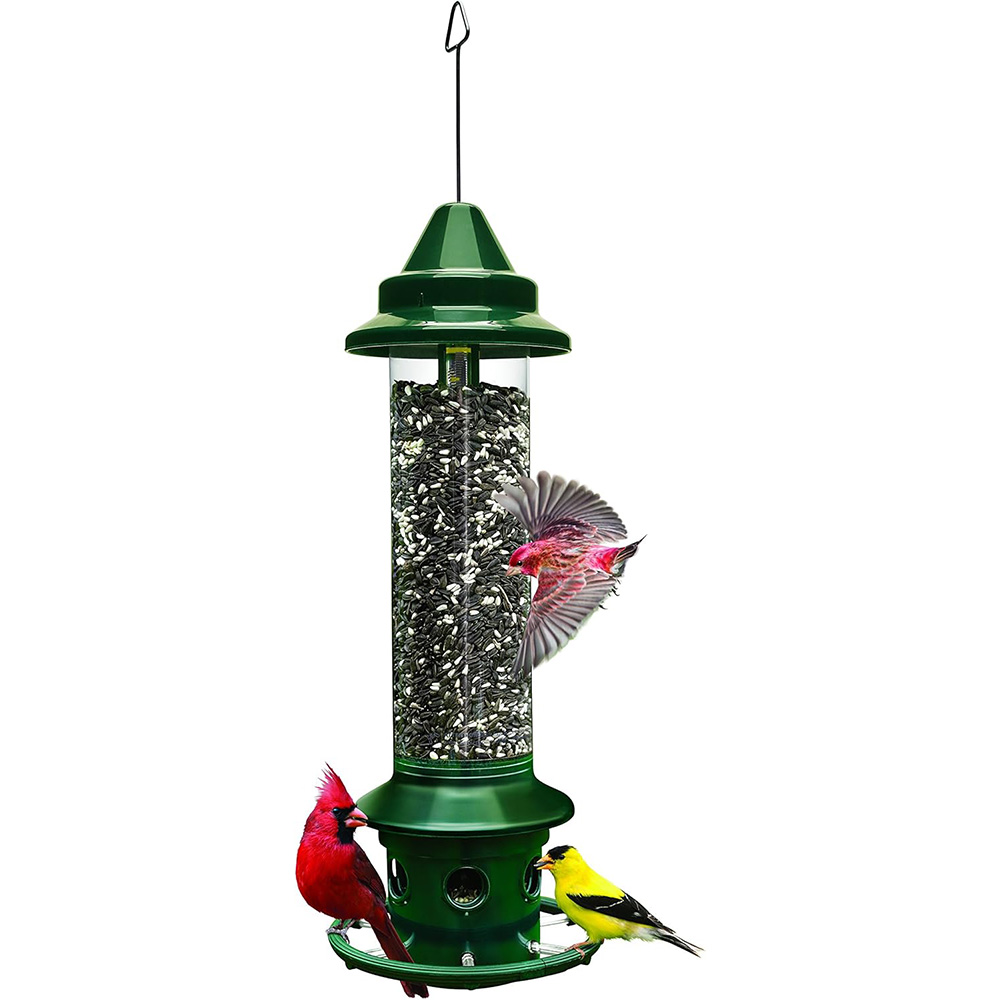
Best overall bird feeder
Although it’s a pricey feeder, visiting birds will thank you for investing in this product. Aside from being capable of withstanding much of Mother Nature’s worst, this waterproof feeder has been designed to keep seeds as fresh as possible for longer periods. It also comes with a comfortable grip that makes it attractive to small and medium-sized birds as well as a perching platform broad enough for colorful cardinals. In that sense, it justifies the price.
But wait. There’s more. This feeder is squirrel proof as well. When an adult squirrel climbs on to the feeder, its weight forces a shroud down over the ports. The feeder also boasts chew-proof materials made of a special, tooth-proof patented RoxResin compound. It’s certainly impressive.
Should something go wrong, the company offers lifetime support and will usually replace faulty or damaged parts free of charge. Just be aware you’ll need to wash the feeder by hand. It can’t be popped into the dishwasher.
Reasons to buy: Capable of storing large feeds and suitable for different-sized birds, this stylish feeder is wonderfully squirrel-proof.
Reasons to avoid: You will need to wash the feeder by hand and more affordable feeders are available.
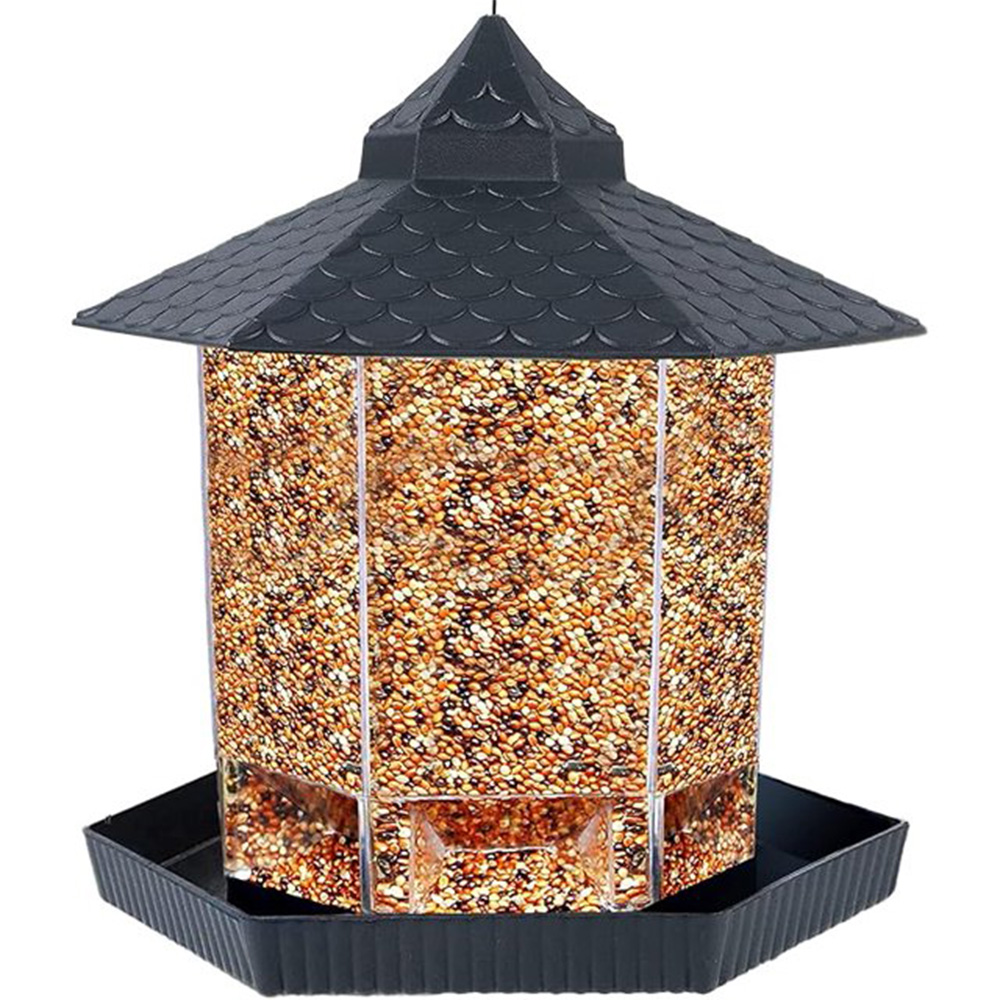
Best budget bird feeder
The Twinkle Star Wild Bird Feeder is great for those on a budget. Although made of plastic, it’s sturdy and keeps bird feed dry. It’s also quick and easy to fill and has a large grain capacity of more than 2lbs. A durable wire makes it easy to hang too.
In that sense, the designers have created a strong product and it’s certainly attractive with its fetching hexagonal design and charming green base and sloped, sheltering, tile-effect roof. It can be easily taken apart and cleaned with mild soap and water which helps to maintain the health of your local bird population. And it’s capable of being filled with a range of mixed seeds – its six-sided design will encourage a range of birds to feed from it without any fights in the dinner line.
It will only be suitable for smaller birds such as finches, robins and chickadees, however, so if you want to attract large birds, you may want to look elsewhere.
Reasons to buy: This affordable, attractive feeder is great for beginners and easy to fill and clean.
Reasons to avoid: It is not suitable for larger birds and it won’t stop squirrels munching on the seeds either.
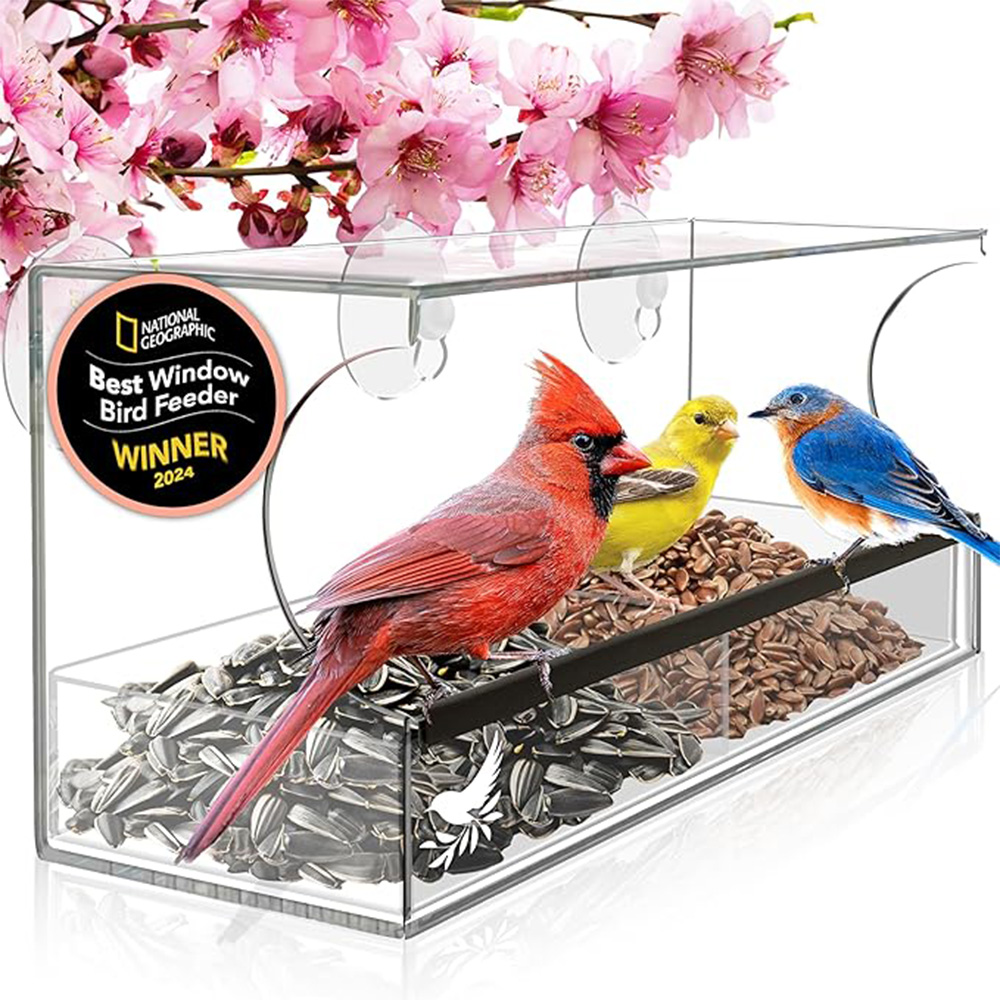
Best window bird feeder
You can enjoy the beauty of your favorite birds close-up with this transparent window bird feeder that can be easily mounted to the outside of any window. Measuring 11.8 x 5 x 4 inches, this large and impressive feeder has strong suction cups to ensure it stays in place, and the durable all-weather design makes it perfect for every season.
With drainage holes to prevent mold from growing on the seeds and in the tray, it also has a lightweight design that makes it easy to take down and clean. The bird feeder can hold four cups of seeds, twice as many as most feeders, and includes a removable tray for easy refilling.
The comfortable perch design features a padded grip on the seed tray, encouraging birds to stay for longer, and the top cover keeps them protected from rain and snow. You can also make this feeder squirrel proof by ensuring it’s mounted to a window that is away from any jump-off points.
Reasons to buy: This feeder, with its durable rain-proof design, offers great close up views of birds flocking to your home.
Reasons to avoid: You will need to mount the feeder as high as possible to prevent squirrels from reaching it.
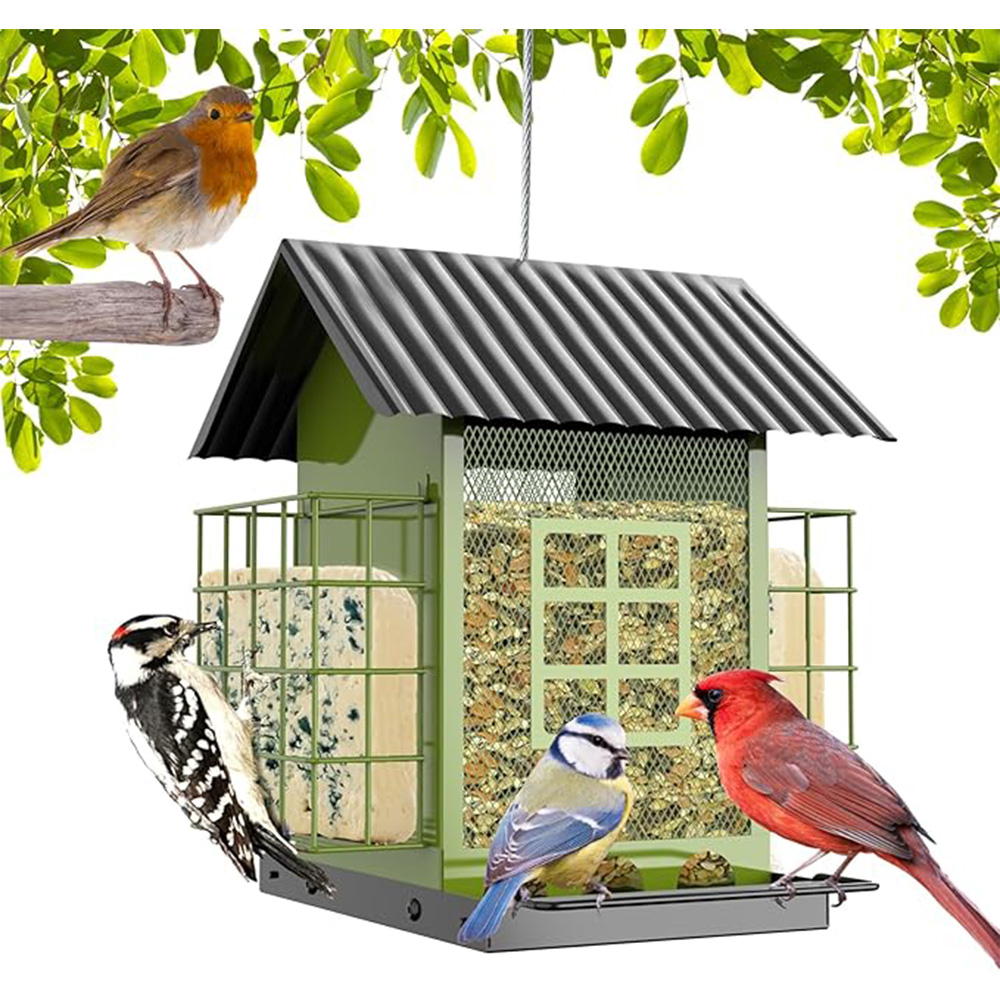
Best suet bird feeder
If you are looking to give birds suet that is nutrient-rich and high in fat then this dedicated feeder should be high on your list. Aside from being waterproof, it’s well-built and solid which should mean you won’t be rushing to replace it for a very long time. It also has a large 3.7lb seed capacity so as long as you get a regular stream of visitors, you can fill it up and enjoy watching the comings and goings of starlings, blue jays, sparrows and more.
Cleaning the cage is as easy as rinsing and filling the feeder is simple too. The roof slides away and that leaves plenty of room to pour in seeds from the top. There’s also a tool which then lets you lock the cage so that it doesn’t accidentally slide out when birds stand on the feeder’s perch. And since the roof overhangs, it should stop water getting on to the seeds although holes on the bottom tray should drain most if not all of it away.
Reasons to buy: With bird feeders on the outside and suet cages within, this product will cater well for your visiting feathered friends.
Reasons to avoid: Some owners have reported squirrels being able to knock the feeders and gain access to the seeds.
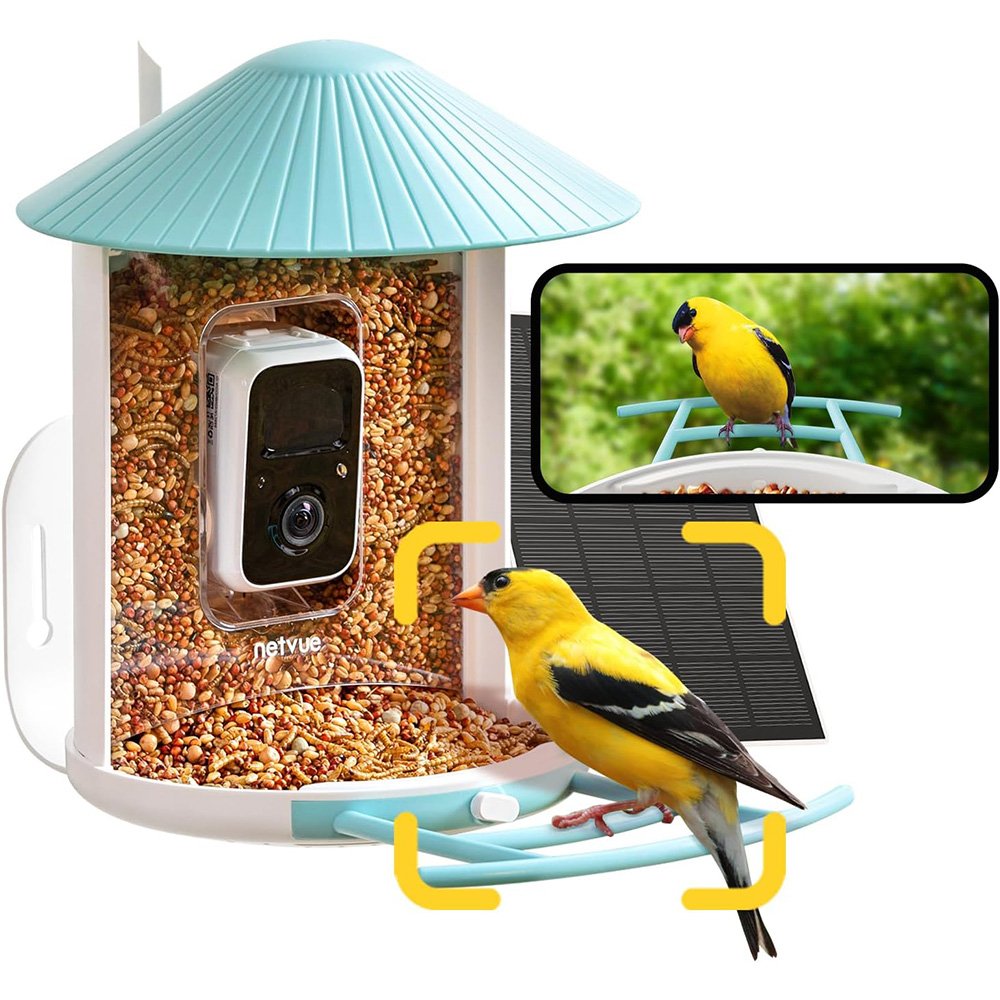
Best technical feeder
Although filling bird bellies is a primary motivation for having a feeder, bird-watching soon becomes addictive. Buy this amazing feeder and you’ll be hooked even more because it comes complete with a built-in camera which not only films the coming and goings of birds but lets you know when they pay a visit as well.
The feeder syncs with a smartphone app and videos are automatically uploaded to the cloud so you can view them without having to take up space on your device. Thanks to AI, Birdy will also identify the species which visit but you will need a subscription for this (there is a seven-day free trial).
In any case, the 1080p camera will pick up the birds in high resolution, even when it’s dark since it has color night vision. You can zoom in up to eight times and get mega close-up shots. It’s also possible to quickly keep the feeder clean and topped up with food and since it’s weatherproof, you can be assured the camera is protected and the food doesn’t go moldy.
Reasons to buy: This takes bird watching to a whole new level by allowing you to view high quality images and video.
Reasons to avoid: You will need to pay for features such as cloud storage and AI detection.
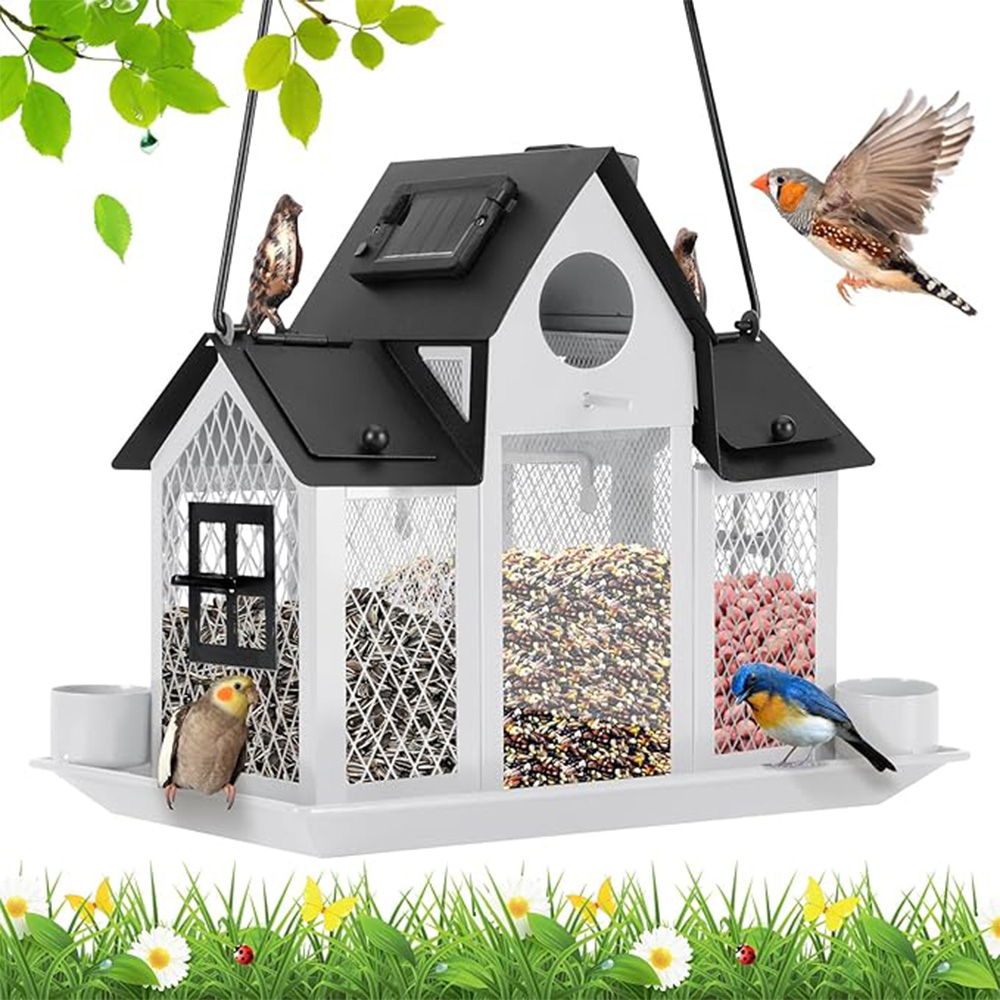
Best versatile feeder
This feeder has been designed to light up your garden – literally. So, as well as getting a lovely-looking feeder that has three compartments for different types of seeds, you also get a solar-powered garden light, which will look rather stunning at night.
The feeder should last you a while although the amount of light you get will, of course, depend on how much daylight the solar-panel receives to charge it up. At the very least the feeder is said to be rust-resistant, chew-resistant and weather-resistant but some users have reported squirrels getting at the food and the bird seed going moldy.
Those issues can often be resolved with careful positioning in the garden and ensuring the feeder is kept clean and isn’t overly packed with food. As we’d expect, cleaning is easy and the large mesh windows make it attractive to birds while also proving easy to see how much food is left. For a garden feature, it’s one to consider.
Reasons to buy: It will look great in the yard thanks to its solar-powered light and homely styling.
Reasons to avoid: Some users say it’s not as squirrel-proof as claimed and it’ll need to be positioned so that the solar panel attracts daylight.
How we tested the best bird feeders
First of all, we assessed how attractive a feeder was likely to be for a bird and this involved checking how much seed could be kept in a feeder and how easy it would be for the intended varieties to access their food. Second, we looked at the practicalities of a feeder: was it strong enough to cope with the weather, was it waterproof, did it seem robust enough to withstand repeated visitors and could it be easily assembled and fixed if need be? Third, we checked how easy the feeder would be to clean.
What do vets recommend as the best bird feeder
Birds can be surprisingly fussy about where they eat, so if you want certain varieties to visit, the right kind of feeder can be very important. For smaller birds, tube-style feeders that are hung from a height tend to be a favorite among smaller birds and, because they're positioned high up, they're less likely to attract the attention of predators. The same is true of window feeders. “These are best for small birds like finches and sparrows, whereas woodpeckers and jays will enjoy suet feeders,” says Dr MacMillan.
Bear in mind that tube feeders are also popular with squirrels so if this is going to be an issue choose a hopper-style feeder which releases food when it senses a light bird but closes shut when it senses something larger. This method of operation does make hopper-style feeders unsuitable for larger birds though. As such, for larger birds, select a ground or platform feeder, which are easier for them to feed from. The benefit of these is that you could introduce food from your own kitchen.
Which bird feeder features are most desirable?
As a basic, look out for feeders that are durable, easy to maintain and work for the birds that are local to your area. “You should choose a design that has no sharp edges that a bird could injure themselves on and one that is made from a durable and non-toxic material,” Dr MacMillan says.
Added features that help to keep bird seed dry are also advantageous. “It will keep the food attractive for the birds,” Dr MacMillan adds. “Feeders that have a tray underneath to catch stray seeds can also be a good idea as this reduces the risk of accidentally feeding pests like rats in your garden.”
Where should I place a bird feeder?
Once you have bought a bird feeder, you need to consider carefully where it’s going to go. Spend some time outside walking around, looking for ideal locations. “In my experience, situating a bird feeder in a sheltered, undisturbed area of the garden is best,” says Dr MacMillan. “A space that has noisy pets, regularly moving vehicles, or children kicking a ball about is unlikely to be attractive to wild birds.”
Think about other visitors to your outdoor space and how you can tackle potential problems. Small trees, shrubs, or bushes can provide some security for birds visiting the feeder, but you should take care to position it away from large nearby trees, walls, or fences,” Dr MacMillan adds. “Cats and squirrels may use these to gain access to the feeders. The feeder should also be around five feet off the ground so that the birds don’t feel vulnerable while using it. This also makes it easy to top up feed and for cleaning. And of course, situating it in a spot where you can easily enjoy watching the visiting birds is important too!”
How do you keep a bird feeder clean?
Don’t place your bird feeder so high that it’s going to be difficult or even dangerous to take down and clean. After all, it’s important that your chosen bird feeder is kept clean so this is a task you will be doing more often than you think.
“Old food must be removed regularly, and the feeder needs a good wash in warm soapy water (rinse well),” Dr MacMillan says. “Remember that old feed can become moldy, especially during warm and damp conditions, and diseases can spread through multiple birds contacting the same feeding station.”

Dr Rebecca MacMillan is a companion animal vet who has always had a passion for writing and client communication. She works in the South West and loves complex medical cases.
Get the best advice, tips and top tech for your beloved Pets

David Crookes has been a journalist for almost 30 years and he has written for a host of magazines, newspapers, websites and books including the World of Animals Annual, BBC Earth, Live Science, The Independent and Tom’s Guide.
Born in England, he lives with two cats but he’s also keenly interested in the differences between the huge number of dog breeds – in fact, you can read many of his breed guides that he’s written in collaboration with vets here on PetsRadar.
With a lifelong passion for technology, too, he’s always on the lookout for useful devices that will allow people to keep their pets happier and healthier, and provide them more time to spend together.
David has a degree from Durham University, as well as postgraduate diploma in journalism from the University of Central Lancashire.
